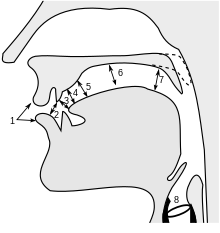Consoante glotal
| Pontos de articulação |
|---|
Labial |
| Bilabial |
| Labiovelar |
| Labioalveolar |
| Labiodental |
| Dentolabial |
Bidental |
Coronal |
| Linguolabial |
| Interdental |
| Dental |
| Dentoalveolar |
| Alveolar |
| Apical |
| Laminal |
| Subapical |
| Palatoalveolar |
| Alveolo-palatal |
| Retroflexa |
Dorsal |
| Palatal |
| Labial-palatal |
| Velar |
| Uvular |
| Uvular-epiglotal |
Radical |
| Faríngea |
| Epigloto-faríngea |
| Epiglotal |
Glotal |
Esta página contém informações sobre fonética usando AFI, e podem ser exibidos incorretamente em alguns navegadores. Saiba mais |
Uma consoante glotal ou simplesmente uma glotal é uma consoante com o ponto de articulação na glote em sua pronúncia, seja por um estreitamento, seja por uma oclusão, como a glotal na língua árabe, a qual tem a maior parte das palavras compostas pela sequência C-C-C, ou seja, três consoantes das quais as glotais /h/ e /ʔ/ podem ocupar quaisquer posições.[1]

As consoantes glotais são divididas em quatro distintos modos de articulação: o fonema [ʔ] é uma oclusiva, sendo a única glotal presente no português brasileiro; o [ʔh] é uma africada não-sibilante; o [h] e [ɦ] são ficativas não-sibilantes, sendo o primeiro desvozeado e o segundo vozeado; e o [ʔ̞] é uma aproximante.[2]
Ponto Modo |
Glotal |
|---|---|
| Oclusiva | ʔ |
| Africada não-sibilante | ʔh |
| Fricativa não-sibilante | h ɦ |
| Aproximante | ʔ̞ |
Características
[editar | editar código-fonte]- É definida como o espaço entre as vogais (intervocálico).[3]
- O som é articulado no início da laringe, imediatamente após a glote. Ajustado pela cartilagem aritenoide, abaixo da epiglote.[3]
- Possui quatro distintas formas de vozeamento: vozeada, sibilante, não-sibilante e desvozeada.[3]
Características apresentadas na tabela exemplar a seguir:[2]
| IPA | Descrição | Exemplo | |||
|---|---|---|---|---|---|
| Língua | Ortografia | IPA | Significado | ||
| ʔ | oclusiva glotal | Português do Brasil | Hã-hã | [ɐ̃.'ʔɐ̃] | Expressão de negação |
| ʔh | africada glotal desvozeada | Chinês (dialeto yuxi) | 可 | [ʔ͡ho˥˧] | Posso/poderia |
| h | fricativa faringal desvozeada | Inglês | hat | [ˈhæt] | Chapéu |
| ɦ | fricativa faringal vozeada | Tcheco | Praha | [ˈpra.ɦa] | Praga |
Referências
- ↑ Hayes 2008, p. 84.
- ↑ a b «IPA Chart». Interactive IPA Chart
- ↑ a b c Ladefoged & Johnson 2010, pp. 148-149.
Bibliografia
[editar | editar código-fonte]- Ladefoged, Peter; Johnson, Keith (2010). A Course in Phonetics (em inglês) 6ª ed. [S.l.]: Wadsworth Publishing. ISBN 1428231269
- Hayes, Bruce (2008). Introductory Phonology (em inglês). [S.l.]: Wiley-Blackwell. ISBN 1405184124
Text is available under the CC BY-SA 4.0 license; additional terms may apply.
Images, videos and audio are available under their respective licenses.
